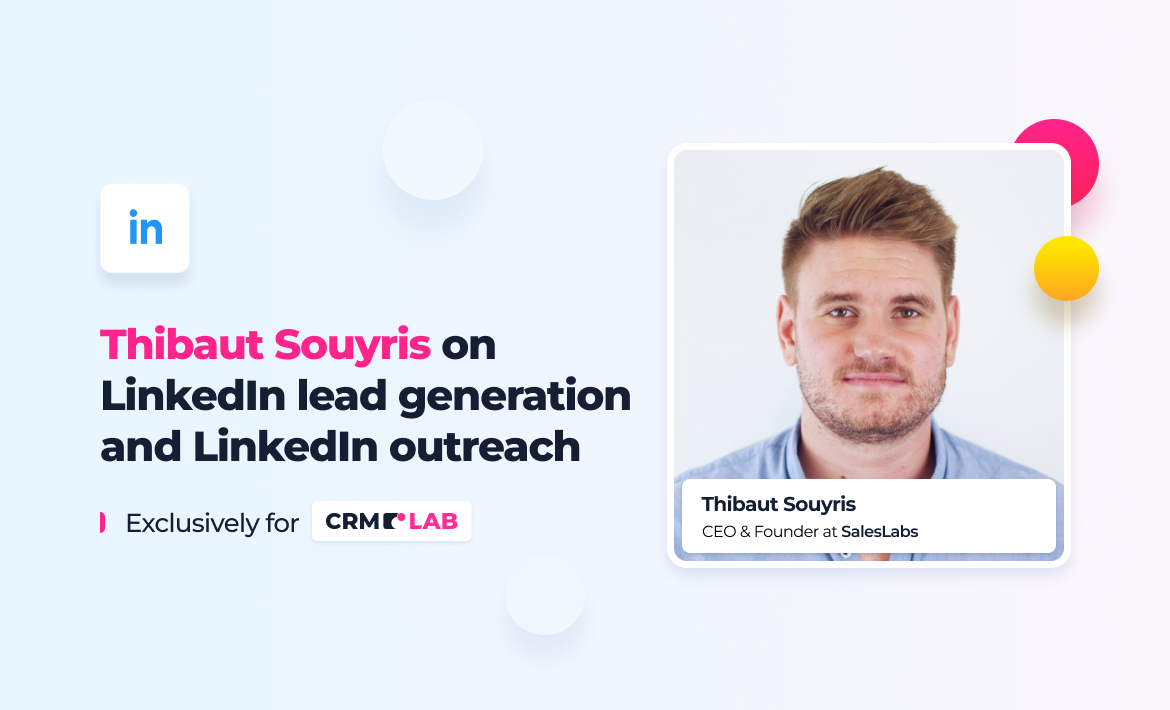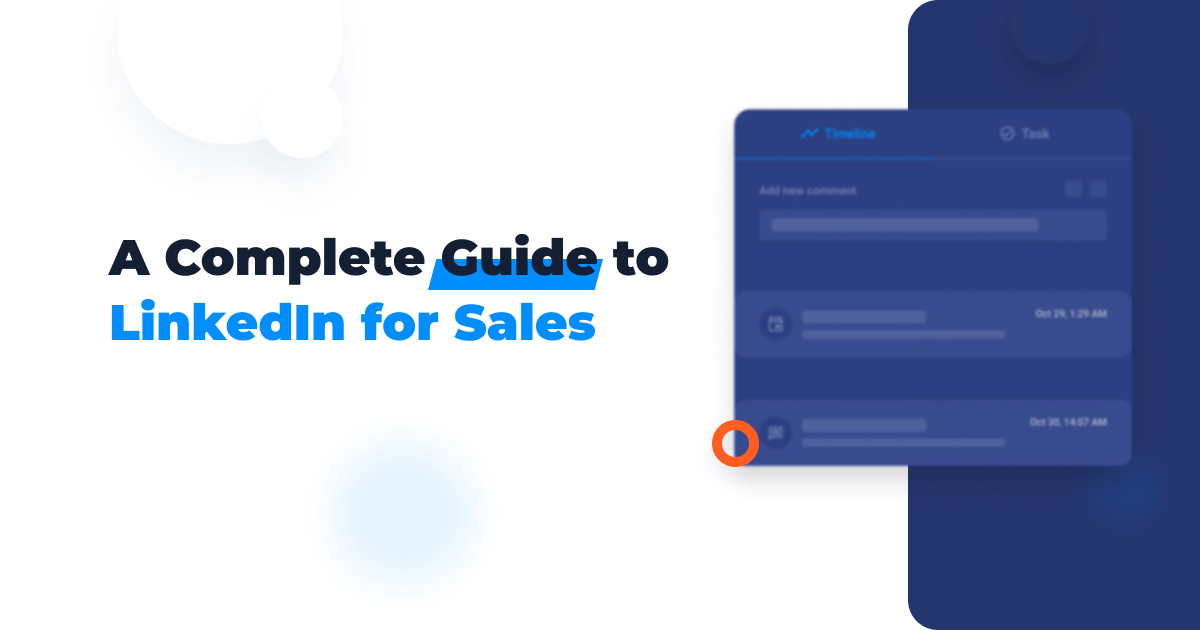Here are the best strategies to fill your sales pipeline with high-quality leads from LinkedIn
LinkedIn prospecting is proven to be a great tool for B2B salespeople, especially if they’re proficient in crafting effective LinkedIn sales messages. LinkedIn offers a heap of functionality to fill your sales pipeline with high-quality leads. As more and more salespeople realise this, decision makers’ inboxes get increasingly more clogged with outreach messages.
Unfortunately, those messages rarely evoke any interest in recipients. They’re often too general, not personalised and overly salesy.
You can only enjoy an increase in sales if you know how to reach out on LinkedIn effectively. Writing high-converting LinkedIn sales messages or crafting LinkedIn Sales Navigator message templates for your team to use can be a tough task, unless you know how to do it. We want our readers to be successful with their LinkedIn outreach and write messages that get traction instead of simply annoying the prospects.
In this article, we share the red-hot tips for LinkedIn prospecting, along with the four best strategies to convert your LinkedIn prospects into leads, including some of the best LinkedIn messages for sales and follow-up message templates!
Let’s get converting!
Tips for LinkedIn sales prospecting
There are lots of different tips and tricks for successful LinkedIn sales cold outreach. One of them is using special LinkedIn tools for sales. However, none of them will work unless your profile is in top-notch shape and ready to be used. First impressions matter! In the realm of LinkedIn prospecting, your LinkedIn profile is the first impression you make.
Optimise your profile
If you reach out to prospects using a seemingly fake or spammy profile, chances of getting a reply, let alone landing a deal, are low. You need to showcase your credibility as a salesperson immediately. Your prospects need to see that you represent a real business, not some dodgy company with a questionable offer, trying to steal hard-earned money.
Here are the key elements of your LinkedIn profile...
- Profile Picture. Make sure your profile picture is professional, high-quality and shows your face - preferably a smiling one. People tend to trust others more when they know what they look like.
- Header and About. Add more details about who you are and what you do. The About section is the perfect place to tell how you and your product help your prospects succeed.
- Work Experience. Make sure you let everyone who visits your profile know what your role in the company is. Lack of detail can be suspicious, especially when you start pitching products and services.
By the way, we recommend actively engaging with the LinkedIn community so that your profile appears more lively and, therefore, doesn’t come across as a fake used only for sales. Set yourself the target of one LinkedIn update a day. Just take 60 seconds to think of something interesting to say! Download our checklist for the perfect sales manager's LinkedIn profile.
The shorter, the better
To master the art of LinkedIn cold outreach, you need to understand the difference between LinkedIn sales message templates and cold email templates. While they serve the same purpose - to engage with a prospect in a way that eventually lands your business a deal - there’s a big difference between the two.
Email is a communication channel meant for longer messages; LinkedIn is more similar to texting. Even the interface of the platform suggests that. LinkedIn messages appear in a small window with a limited amount of symbols visible to the user without scrolling. If you want all of your message to be visible to the recipient straightaway, it should be around five to seven sentences long.
Hint: If your prospect needs to decide whether or not to read the message once they open it, then it’s too long! Not only is it annoying for your prospects to have to put in more than minimal time and effort into reading a message from someone they don’t know, but it instantly makes your message look spammy.
Your message needs to be no longer than a few powerful sentences. Especially if it’s the optional message you send along with the connection request, limited to 300 symbols.
Maximum personalisation
Personalisation is the kingpin of sales. Unless your sales pitch is highly relevant to a prospect; tailored to meet their particular business needs, your outreach will be unsuccessful.
When crafting a LinkedIn sales message, warm it up a bit and extend personalisation beyond just using the prospect’s first name and mentioning the company they work at. Instead, you need to show that you genuinely care about their business success and have a valuable offer to make. You need to research the company and find out what their workflows look like, what kind of pain points they have and what solutions they seek.
But even before you propose your offer as a solution, you need to make sure that you don’t sound robotic. Don’t use generic phrases and vague compliments...
Add specifics to show that it’s not a mass-send campaign but rather a personal message.
Automation is one of the biggest trends in sales nowadays, so it’s only natural that you’d want to make your life easier and try to automate your LinkedIn messaging. This is a slippery slope. Unless you’re 100% positive about your LinkedIn outreach software’s ability to provide the required level of personalisation, we recommend you refrain from using it.

Create an omnichannel follow-up sequence
Sales outreach is all about creating a sequence of multiple touches so your business stays on top of the prospect’s mind. In order to make your omnichannel follow-up as efficient as possible, use the appropriate software. Here’s how you can create an omnichannel follow-up sequence with NetHunt’s CRM Integration with LinkedIn.
- Sign Up for NetHunt CRM.
- Download the NetHunt CRM for LinkedIn Chrome extension.
- Go to LinkedIn and find companies that match your criteria or the ones that you already reached out to.
- Add them one click into the CRM, and have the records already enriched with available LinkedIn data (picture, full name, contact details, job title, company, etc.)
- If you need to add companies and tie multiple contacts to them, it's also possible to do so with NetHunt CRM.
- Create a personalized email campaign.
- Set up automated follow-up email sequences, if needed.
Find common ground
It’s easier to connect with prospects and personalise your outreach when you have something in common. That thing you share can then become a great icebreaker and help you start a conversation in a natural way.
The beauty of LinkedIn is that it makes it easy for salespeople to find common ground with their leads. All they need to do is examine their prospect’s profile (or use LinkedIn filters) and see what catches their eye. Here are just a few examples of what you can use in your first prospecting message (LinkedIn connection request message) to increase the chances of getting a response.
Professional experience, skills, current or past jobs: "Hey [Name], I can see that you’ve attended the [Title] webinar. It would be nice to chat with someone who has an interest in X. I’d love to have someone to discuss it with - let’s get connected!"
LinkedIn groups: "Hi [Name]. You’re a member of [Group], too, aren’t you? I assume you’re interested in X. Your experience is quite relevant to what I'm doing, I’d like to learn more. Let's connect to keep updated."
Posts, comments and likes: "Morning, [Name]! I’ve seen the comment you left under the post about X. I agree with you entirely and would like to find out what you think about Y. Would you like to connect so we could chat?’
Local area: ‘Hey [Name]! I’m from [Area], too! It’s so great to see people from the local area here. I’d love to build a network of local like-minded professionals - would you like to connect?’
Shared connections: ‘Hey [Name]. You and I both know [Name of shared connection]. I assume you, too, are in the [industry] industry. It would be great to connect with more people from the field.’
Double-check your facts
In the pursuit of increased personalisation, salespeople try to include as many facts they know about their prospects in the outreach message as possible. Indeed, showing your prospects that you’ve done your research and can offer them some real value can be a winning strategy. But only if your facts are correct. Take a look at these LinkedIn messages...
Is this a good sequence of messages? A pretty solid one, if you ask me. The salesperson found the common ground, showed that they’ve researched our business, and established themselves as an expert in the field; ready to provide some real value. But ask me if this is an effective email sequence... Not at all!
Why? The salesperson got it all wrong. We don’t actually use X, so the rest of the messages aren’t relevant to us; what a waste of time.
If you build an elaborate sequence of LinkedIn messages around a fact that isn’t relevant to your prospect, they’ll immediately clock what you’re up to and either ignore your message or send it to their work chat to make fun of a lousy outreach effort.
Stay away from pitching in the first message
LinkedIn isn’t a marketplace for products and services, it’s social media for professionals to connect and build meaningful business relationships. You need to focus on building a relationship, before you try and sell a product.
It’s best to open up a dialogue with something only vaguely related to your offer; only start promoting a solution once you’ve established at least some sort of connection with the prospect. We’re not talking months of chat, of course - just save the commercial offer until the second or third message in the outreach sequence.
Tip. If you’re a salesperson using LinkedIn for sales outreach, stay away from InMail for cold outreach and product pitching. They’re meant for recruiters, so let’s leave it that way. While InMail does help you to get into the prospect’s inbox and send them a message longer than 300 characters without having to connect first, they also make your outreach appear salesy and automatic.
To make outreach appear less salesy, it’s best if you focus it on your prospect rather than marketing yourself. One of the common mistakes sales newbies make is being all ‘me’ when reaching out to prospects on LinkedIn. Don’t start every sentence with ‘I’ and ‘my business’. Instead, go for more ‘you’ and ‘your business’. Once you craft your pitch, check out how many 'I' and 'my' it contains compared to 'You' and 'Yours'.
By doing so, you effectively communicate that outreach by trying to be of use to your prospect.
"Hey [Name],
Your profile caught my eye – seems like you’re doing an amazing job on lead generation, and I’d love to learn more about your process.
At the same time, I could talk you through a couple of ways we help our customers save time on customer relationship management and data entry. How does that sound?"
Strike a conversation
You’re a total stranger. If you received a message from a total stranger, you wouldn’t be inclined to reply unless you had a good reason to, would you? You need to focus on striking a conversation, rather than firing a message and calling it a day. To make your outreach more successful, we recommend including a question that would prompt your prospect to answer your message.
- What do you think about X?
- Have you worked with Y?
- What are your business priorities?
- Did you find the X webinar useful?
- Which features of X didn’t meet your expectations?
Provide value
Even though you don’t want to sell in the first outreach message, you should make it worth reading. There must be clear value for your prospect so that they’d be interested in continuing the conversation.
There are some ways in which you can do that.
State how you can help your prospect. "Hi [Name]! At NetHunt, we help businesses like yours increase their sales with customer relationship management, automated sales, and email marketing. Want to learn more?"
Offer free exclusive resources. "Hey [Name]. As a small business owner, I believe your goal is to grow your business. In today’s business environment, it’s only possible to do if you streamline and organise your processes. Would you like me to share a guide on choosing the right CRM solution?"
Provide social proof. "Hey, [Name]. We have this case study on how we helped a real estate agent to double their sales with the use of a CRM solution. It shows exactly how we did it - would you like me to send it your way?"

The intricacies of LinkedIn message copywriting
Just like in any other type of writing, LinkedIn outreach messages have to be written in a specific way and follow a certain style. Let’s look at the main dos and don’ts of writing a sales outreach message to LinkedIn users.
Only use one font per message. It can be tempting to highlight the key points of your message with a different font, but it makes the copy look sloppy and unprofessional. We advise against using bold, too. It makes it obvious that your message is for commercial purposes because it reads very unnaturally.
CAPS LOCK is a taboo in the world of regular messaging, and it remains one in prospecting communications, too. When you write in all caps, it looks like you’re shouting at the person reading your message.
Don’t send long illegible blocks of text. We’ve already talked about the length of your outreach message - it needs to be short and straight to the point. Now, let’s talk about its structure. It’s necessary for you to structure your message so it’s legible and easy to understand. Finally, be careful with using links. LinkedIn converts links into large previews that can take up a lot of space.
Here’s the structure of the perfect LinkedIn sales message to use in your outreach...
The Hook: The first sentence of your LinkedIn message that the prospect sees without even opening it. It must be engaging, prompting a prospect to respond to a message. Ideally, you should start your message with a witty question. Not only does it help to focus your message on the prospect rather than yourself, but it also starts a conversation. With this question, you introduce the pain your product or service is capable of solving.
The Value Proposition: The body of your message that comes right after the hook. In one or two sentences you must state as clearly as possible what you offer in your role and how it’s a solution to the problem your prospect faces.
The CTA: The final part of your message is where you tell your prospect what you expect them to do next.
Granted, your profile is well-optimised and you’re reaching out to the right target audience, use the aforementioned formula to craft your LinkedIn sales messages and you’ll see an instant increase in conversions. To make your life a bit easier - we all know salespeople have it rough - NetHunt has prepared four effective LinkedIn sales outreach scenarios with plenty of message templates for you to indulge in.
4 effective LinkedIn sales outreach strategies
If you want your LinkedIn sales message to be effective, you need to plan your whole sequence ahead. Below, you can find the four best outreach sequences that will help you land a deal.
The Community Strategy
This strategy is all about finding common ground between you and your prospect and using it to start a conversation. Connect with a prospect on the basis of having something in common, ask some pre-qualifying questions to learn more about their business needs, and pitch your product as a solution to their problems.
To successfully implement this strategy, you need to find an online community that contains your target audience first. We recommend finding an appropriate Facebook group or Slack channel as they seem to be the most active these days. Then, you should scrape the Facebook group/ Slack channel to reach out to its members on LinkedIn. Here’s how...
- Use the Phantombuster Facebook Group Extractor tool to scrape group members for you, if you've chosen a Facebook group for LinkedIn outreach.
- Use the Phantombuster Slack Channel User Extractor to scrape group members for you, if you’re targeting a Slack channel.
- Use the Phantombuster LinkedIn profile URL finder API to find the LinkedIn profile of the people on your list.
Once you have a neat list of LinkedIn profiles to reach out to, you’re ready to set the sequence.
LinkedIn connection request message
"Hi [Name]!
I came across your profile and wanted to reach out as I see we’re both members of the [the name of the Slack community]. I guess we have a passion for sales automation in common.
Amazing!
Let’s connect.
[Your Name]"
The first message
(within 24 hours of connection)
"Hi again, [Name], thank you for accepting my connection request! It’s a pleasure to have someone who’s as passionate about sales as myself in my network.
It’s always interesting to learn about how other companies handle their sales processes - do you have any tips to share? I have some tips to share in return, too. My pocket fairy is [your product]. It helps to [solve a problem]."
Follow-up #1
(1 week after the first message)
"I understand the struggle of handling your sales process manually - it’s always hindered by laborious data entry, incomplete and inconsistent data and way too many follow-ups to keep in mind. I believe your business would benefit from using a CRM solution that offers sales and email marketing automation functionality.
Perhaps, you’d be interested in learning more about NetHunt CRM and how it can help you grow your business?"
Follow-up #2
(1 week after Follow-up #1)
"Does this sound interesting enough to justify a short conversation? Please, drop me a quick message to let me know what you decide."
Follow-up #3
(2 weeks after Follow-up #2)
‘I’d still love to give you a little demo of this tool, [Name]. I promise it won’t take up too much of your time - in 30 mins, I’ll tell you exactly how [their company] will benefit from NetHunt CRM.
It’s a game-changing tool, you won’t regret it: https://calendly.com/nethunt/’
The Let’s Talk About You Strategy
Use this strategy to establish a relationship with your prospects and make an offer in a very subtle way.
Before you pitch your product or service, you need to focus all of your attention on your prospect and their company. Congratulate them with achieving a milestone, reaching a target or meeting a goal of theirs. Then, proceed to offer your product or service - present it as a way to boost the growth of their business.
This is a fool-proof strategy in terms of getting your prospect to respond to your initial message and establishing a two-way communication; no one is rude enough to ignore a ‘congratulations’ message.
Connection request message
"Hey, [Name]!
I’ve seen that your company has recently [mention the achievement they’ve had]. Amazing results!
I thought I’d congratulate you on achieving that directly and ask you for a connection. I have a couple of questions regarding your business journey.
[Your Name]"
The first message
(within 24 hours of connection)
"Thanks a lot for accepting my connection request, [Name]!
Once again, I want to congratulate you on [achievement]. Do you have any tips on it? I’d love to get some insight. By the way, would you be interested in achieving [another goal]? [Your company] has quite some experience with helping businesses like yours overcome [challenges] and achieve [results]. I could tell you more about how we could help your business."
Follow-up #1
(1 week after the first message)
"[Name], now that you’ve reached [the milestone], I was wondering if your priorities have changed. What are your goals for the next [period of time]? Are you planning to grow your business further?"
Follow-up #2
(1 week after Follow-up #1)
"I believe I have a great recommendation for you, [Name]! There’s a cloud-based CRM system called NetHunt CRM, that allows you to streamline your sales and marketing processes via automation. You can automate your lead capture and lead nurturing so that you’d have more time to focus on the tasks that require your attention.
Would you like to hear more about why I think [their company] and NetHunt CRM are a perfect match? Let me know so we could schedule a call."
Follow-up #3
(2 weeks after Follow-up #2)
"[Name], just bumping this conversation up your inbox. I don’t want [their company] to miss out on a chance to grow even further.
Here’s a link to scheduling a short demo call - https://calendly.com/nethunt/. You won’t regret it!"
The Content Retargeting Strategy
This strategy works if you have a lot of expertise in your field and are willing to share it with your prospects in exchange for their interest in your company. All you have to do is find a popular post from a thought leader in your industry, and reach out to the people that have engaged with it.
Connection request message
"Hey [Name]. I saw you [liked/ commented on] [Thought Leader Name]’s post. I’d really love to discuss it with someone interested in the topic. Let’s connect!
[Your Name]"
The first message
(Within 24 hours of connection)
"Thanks for connecting with me. I love to add people passionate about all things CRM to my network.
So, [Name], what do you think about [the topic of the post]? I believe that [your idea]... Do you agree?"
Follow-up #1
(One week after the first message)
"[Name], by the way, I'm a CRM specialist and I have some materials regarding the topic we’ve discussed. How about I send you a complete guide to choosing the right CRM for your business.
Let me know if you’d be interested in giving it a read."
Follow-up #2
(One week after Follow-up #1)
‘[Name], here’s a link to your guide - https://nethunt.com/guides/guide-crm-from-a-to-z. I’d love to hear some feedback - please, be honest!’
Follow-up #3
(Two weeks after Follow-up #2)
"[Name], just bumping this message up in your inbox. Don’t want it to get lost without you seeing the guide. It’s worth reading!"
The Social Proof Strategy
This strategy is great for reaching out to the prospects that have businesses in a position similar to that of your past clients. It’s highly effective because it lets you share social proof and increase the credibility of your offer.
LinkedIn connection request message
"Hey, [Name].
I see that you work at [their company name]. We’ve had a client similar to your business and helped them achieve [the goal you’ve helped them achieve]. I believe that your company could, too, achieve [the goal]. Would you like to connect and discuss this opportunity?
[Your Name]."
The first message
(Within 24 hours of connection)
"Thanks for connecting with me, [Name].
Here’s how [your past client’s company name] managed to achieve [the metric] - [a link to a customer success story/ video].
I’ve done some research on [their company name]. As far as I understand, you currently have a [problem your product solves]. Is that right?"
Follow-up #1
(One week after the first message)
"[Name], let me explain how [your product] helps to [solve the problem]
- Feature 1 helps to [solve problem 1]
- Feature 2 helps to [solve problem 2]
Does that sound interesting to you? We could schedule a quick call and discuss it in more detail."
Follow-up #2
(One week after Follow-up #1)
"Just reminding you that you can still schedule a call to talk about ways to accelerate your business growth. Here’s the link - https://calendly.com/nethunt/"
LinkedIn is a long game for salespeople; you can mix and match your strategies to find the combination that works best for you. That’s why you shouldn’t stop at just one prospecting message template.
Keep experimenting until you find your golden formula that converts the most prospects!
Table of Contents
Crack the sales formula with CRM Lab
Twice a month, receive actionable CRM content to your inbox.


![How to write high-converting LinkedIn prospecting messages [with 28 templates]](/blog/content/images/size/w2000/2024/05/High-converting-prospecting-messages-on-LinkedIn.png)





